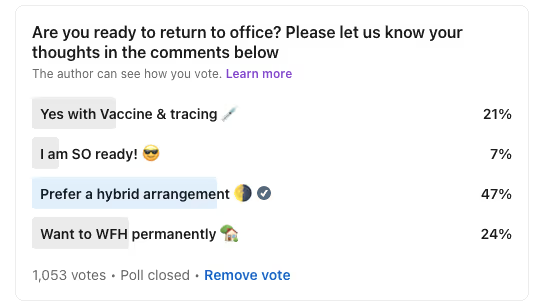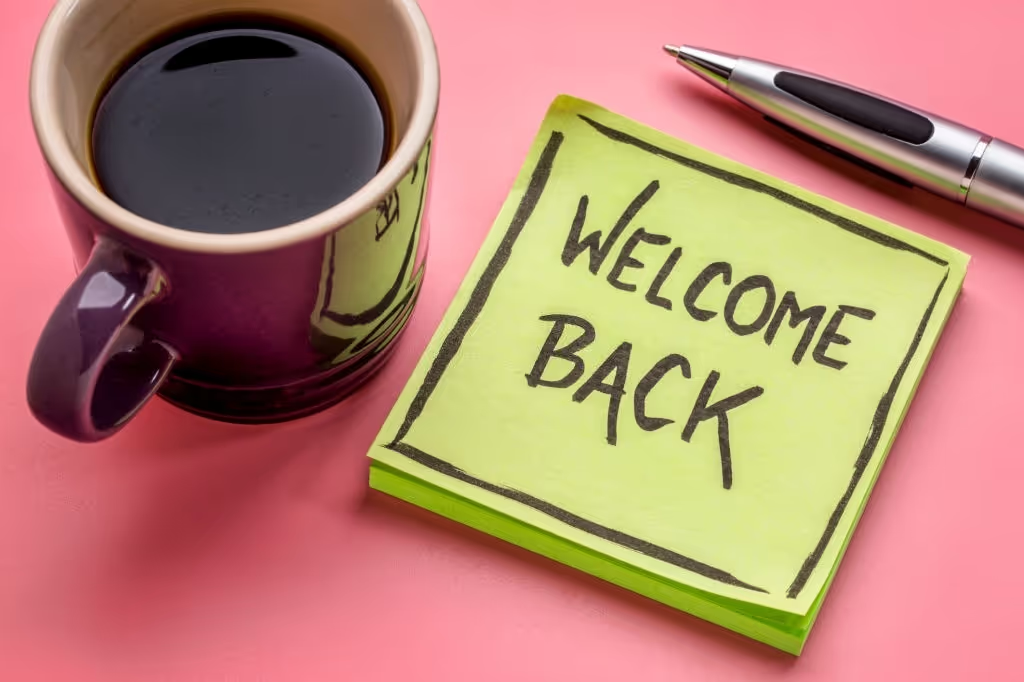peopleHum recently ran a poll on its LinkedIn page, asking about people’s sentiments regarding their readiness to return to office. Among the staff, we were quite divided. We read articles and studies, took part in polls around return to office, hybrid work, and work from home; and we couldn’t figure out what the normal in the new normal could be.
As the votes rolled-in, we found our answer.

Nearly half of the voters preferred the hybrid work arrangement, and a quarter favoured the permanently remote route. However, a fair number were also willing to return, with a majority opting for vaccine and tracing as pre-requisites.
However, responses in the comments were not as black-and-white. The respondents were mostly leaders, coaches, and industry experts. Some made their choice without hesitation, some remarked about the relativity of the options, while others were unsure whether there was a right answer. The one thing that I could gather with certainty was that right answer was dependent on the workforce, culture, leadership, and business model.
Work from home, remote or hybrid working are not new phenomenons. It was only until conversations around their viability started gaining steam; consequently granting us a wealth of data. Conversations on return to office also caught-on by the middle of 2020. Articles between then and now shared a similar opinion - to ensure a safe return where the workplace is both productive and safe. The difference now is the rise in vaccination rates since December 2020. CEOs are optimistic about reopening offices and are ramping up plans for the same. However, you can’t prepare employees to return to the office without accounting for their reality.
Employees’ reality of work during Covid-19
The reality, as derived from the results of a survey conducted by the Best Practice Institute, is that while 83% of CEOs want to see employees back in office, only 10% of employees shared a similar positivity. The prime concern among respondents was about safety.
The results from a FlexJobs survey of remote employees echoed a similar concern, where 49% of respondents were concerned about Covid-19 exposure, 46% were afraid about having less work flexibility, and 43% about less work-life balance.
Business has dropped and employees are concerned about the future of their jobs. Over 60% of employees said the wouldn’t be comfortable about returning to office without trusting their company’s confidence in communicating the necessary information.
Remote or hybrid working practices seem to be highly favoured amongst employees; to the extent that 58% of workers threatened to quit if they were denied the freedom and flexibility of working remotely. With these in mind, companies are going to have to need to reasonably submit to the needs of employees while balancing it with company plans to prepare employees to return to the office.
How about implementing the solutions listed in the next section?

How to prepare employees to return to the office
1. Elaborate safety measures
In the list of concerns, safety has always been the number one issue. To prepare employees to return to the office, they need to be made to feel safe, physically and mentally. In order to gain the trust of employees, communication and transparency is mandatory.
Leaders and managers should transparently describe how they’re planning to make the workplace safe by communicating the company’s safety initiatives and policies. These include norms on physical distancing in the workplace, wellbeing surveys, personal protective requirements, hygiene requirements, and others. The workplace, as we know it, will be transformed. Therefore, employees back in office should coordinate with their company’s return to office team to ensure that they fully understand the procedures.
2. Flexibility in choice
It is important to be mindful about the roles that wish to return. The workforce consists of people representing every generation; and with Gen Z only just introduced to the world of work, remote working is all they have ever known. Early-in-career employees thrive in an environment where they can collaborate and meet their peers. Employees with kids and elderly folk may opt for a hybrid workplace. Employees worried about the commuting long distances through public transportation would prefer to work in fully remote or hybrid roles.
Leaders should have an open dialogue to identify these employees and scenarios, and come up with a work arrangement that works best for the employees and the company.
3. New technology
Access control technology will be one of the newest entrants in the workplace rehabilitation scenario. This process may involve a multi-step screening process before employees are allowed to enter the workplace. Bridging the gap between employee needs and office security, it's essential to consider business door security systems for the modern workplace. Implementing robust commercial access control systems not only safeguards your assets but also ensures peace of mind for returning employees. This strategic approach reassures staff about their safety in a post-pandemic work environment. Access control technology will play a key role in screening and tracking employees at the risk of carrying a contagion.
Smart buildings take on a new meaning in a socially distanced workplace. With sensors and the power of analytics, companies can plan seating allocations based upon social-distancing guidelines. There are apps that eliminate the need for screen cards another near-field communication. Instead, with contactless communication measures like QR code scanning, geo-tagging, and cashless transactions, the Post pandemic workplace will witness a host of digital integrations.
4. Communication binding it all together
In order to ensure that employees feel comfortable to return to the office, they need to know what to expect. Leaders must communicate their plans well in advance and utilise different platforms like emails, video meetings, work app announcement features, so that the team is always in the loop.
It is vital that new workplace protocols are communicated frequently through verbal, written, and other mediums. Posters emphasising workplace safety protocols, announcements are great methods of reinforcing the message. Frequently gauging employee sentiment through surveys, feedback and suggestions can also foster better communication.
5. Introducing newer benefits
Leaders may need to introduce newer employees to the office. These may range from mental health support, providing caregiving services, financial perks, training, and others.
Utilise surveys to understand employee opinions and needs, and find out what the organisation can offer in terms of support. Employee wellness and safety are priority #1, and expectations for well-being programs, mindfulness programs, mental-health time-offs, and tools for scheduling are very high.
6. Rethinking the physical workspace
Reopening the workplace will mean creating a space that employees will want to come back to. This means observing social distancing and hygiene practices in the office. While planning the return to office, HR and leaders must ensure that workplace safety guideline are in compliance with CDC rules. Once they understand the regulations that apply, the Post pandemic workplace must be prepared for returning employees. Here are examples of a few procedures workplaces can follow:
- Workspaces and other frequently touched surfaces like doors, stairwells, elevators, dining spaces should be disinfected and cleaned regularly.
- Seating arrangements must be re-mapped in accordance to distancing norms.
- Set up posters with helpful tips on how to uphold hygiene rules and navigate shared spaces.
- Keep track of employees and their wellbeing through attendance, temperature checks, wellness surveys, and geo-tagging.
- Dining areas are another communal hotspot and another high-risk area. Therefore, to avoid the risk of infection, organizations must encourage employees to prepare their own meals or provide them with individually packed
- Set up shifts for break times, or encourage employees to eat at their workstation or outdoors rather than sitting together.
- Keep sanitising equipment like masks, gloves, cleaning wipes, and hand sanitisers readily available.

Conclusion
Under the peopleHum poll, people also discussed about the social aspect of working from office; that they missed the spirit of collaboration, the face-to-face contact and personal relationships. By adopting these safe return-to-office measures to prepare employees to return to the office, we may be able to shift back to office life, but there’s going to be a noticeable change in dynamics. Absolute remoteness between teams may not turn out to be the most feasible option, and eventually, employees will have to trickle back into office. If anything, the fear of missing out will prompt employees to return.































.avif)



.avif)
%20(1).avif)
.avif)












